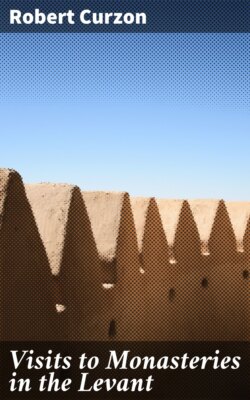Читать книгу Visits to Monasteries in the Levant - Robert Curzon - Страница 5
На сайте Литреса книга снята с продажи.
ОглавлениеKOORD, OR NATIVE OF KOORDISTAUN.
The Armenian monasteries, with the exception of that of Etchmiazin and one or two others, are much smaller buildings than those of the Greeks; they are constructed after the same model, however, being surrounded with a high blank wall. Their churches are seldom surmounted by a dome, but are usually in the form of a small barn, with a high pitched roof, built like the walls of large squared stones. At one end of the church is a small door, and at the other end a semicircular apsis; the windows are small apertures like loop-holes. These buildings, though of very small size, have an imposing appearance from their air of massive strength. The cells of the Armenian monks look into the courtyard, which is a remarkable fact in that country, where the rest of the inhabitants dwell in burrows underground like rabbits, and keep themselves alive during the long winters of their rigorous climate by the warmth proceeding from the cattle with whom they live, for fire is dear in a land too cold for trees to grow. The monasteries of the various sects of Christians who inhabit the mountains of Koordistaun are very numerous, and all more or less alike. Perched on the tops of crags, in these wild regions are to be seen the monastic fastnesses of the Chaldeans, who of late have been known by the name of Nestorians, the seat of whose patriarchate is at Julamerk. They have now been almost exterminated by Beder Khan Bey, a Koordish chief, in revenge for the cattle which they were alleged to have stolen from the Koordish villages in their vicinity. The Jacobites, the Sabæans, and the Christians of St. John, who inhabit the banks of the Euphrates in the districts of the ancient Susiana, all have fortified monasteries which are mostly of great antiquity. From Mount Ararat to Bagdat, the different sects of Christians still retain the faith of the Redeemer, whom they have worshipped according to their various forms, some of them for more than fifteen hundred years; the plague, the famine, and the sword have passed over them and left them still unscathed, and there is little doubt but that they will maintain the position which they have held so long till the now not far distant period arrives when the conquered empire of the Greeks will again be brought under the dominion of a Christian emperor.
